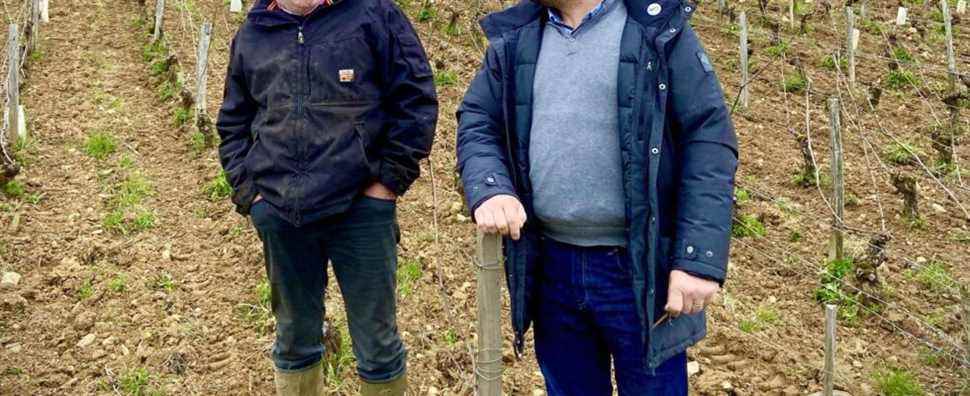The vineyard of the Côte Saint-Jacques (already mentioned from the year 1082), located in the Yonne, near Joigny, would it be the least extensive of the great Burgundy with its some 360 small works (about fifteen hectares)? Good question for idle sommeliers! Resurrected with its gray wine made from Pinot Beurot, the northernmost appellation of the Burgundian region is the very example of these little Burgundy nuggets which, like a lost piece of puzzle, nevertheless complete a very coherent wine picture.
This is also Burgundy. This former administrative region made up of the departments of Yonne, Côte-d’Or, Nièvre and Saône-et-Loire suggests that we will never quite get around it. And, trust me, that’s fine. I have never set foot in the Côte Saint-Jacques appellation, even less on the western edge, on the side of the Coteaux de Tannay (21 ha) and the Côtes de la Charité (45 ha), on the borders of the Loire Valley.
This is better known, at least in Quebec, with for example the distinguished ambassadors of the La Sœur Cadette and La Croix Montjoie estates, the Bourgogne Vézelay appellation (currently 70 ha planted out of a potential 250 ha) leaning against the gates du Morvan is clearly carving out a place of choice on the Burgundian chessboard. And in the hearts of local consumers who have a good sense of the authenticity/quality/price aspect of the wines on offer. The duty was on site last week, after, it goes without saying, the usual meditation at the Sainte-Marie-Madeleine basilica in Vézelay.
Burgundy Vezelay
The history of the Montanets is undoubtedly recent, but it testifies to the obstinacy of peasants who have become winegrowers, whom nothing discourages. A family which, at the time (1999), was to constitute one of the first two domains dedicated to organic farming in the Yonne. The Montanets are first of all the patriarch Jean, with whom, obviously, we do not walk on the arpions. “Outsider from outside”, here he meets his companion, Catherine, whose interest in polyculture, but more specifically for the vine, leads him to seize mentors like the Chablisien Bernard Raveneau and, later, Lapierre and Pacalet in Beaujolais (not the last to come!) claiming to be a fine wine, a healthy, honest and digestible wine which, until today, marks the style of the house.
President until 2003 of the cooperative that he himself created, Jean will leave it, undoubtedly disappointed with the prices granted by the latter for his own organic production, but now freed from all constraints. A slump follows, because without a client on the horizon, given his past as a cooperator. The man will meet the American importer Kermit Lynch the following year, who buys him neither more nor less than his entire harvest. More than butter on spinach, it is a promotion of his convictions that he shares on his own vineyard (11 ha at Domaine de la Cadette) and on that of his partner (8.5 ha at Domaine Montanet-Thoden) . Two entities supplemented by another twenty hectares (Les Sœurs Cadettes), which now runs the son Valentin from the height of his 35 years.
If the trading structure that Valentin has developed (to ensure a cash flow) makes it possible to vinify Burgundy melons (from Muscadet), Gamays (from Chénas and Juliénas in Beaujolais), Chardonnays and Pinot Noirs ( du Mâconnais) with the same fervor of transparency and integrity as the fruit of his own vineyards, the winegrower is not of any stylistic chapel, if not that of loyalty to the terroir “I like to think of wine in image of the legibility of a dish in the kitchen, in this spirit of traceability and natural accompaniment. »
With a production reduced by 92% for the 2021 vintage (damned frost!), it will not only be necessary to support Valentin for the vintages to come (and all the winegrowers “grilled” by the scourge) by already concentrating on the Burgundy The Younger Sister 2020 ($25.55 – 11460660)both clean, sapid, light, precise and thirst-quenching (5) êêê, but also be sure to put aside a few bottles of La Chatelaine 2019 ($36.25 – 11094621 — coming April), a parcel-based cuvée that sums up the complexity of the Vézelian subsoils, but “which has the taste of the place”, as the winemaker likes to mention. Energy, elegance and high palatability, with a particular sensuality that perhaps escapes Chablis wines, which are often more vertical. (5) ★★★ 1/2 ©
